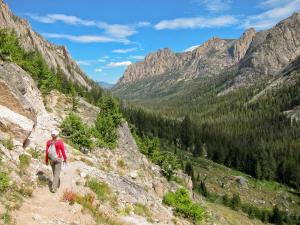WASHINGTON — Scientists have confirmed what every backpacker already knows: the heavier the pack, the steeper the hill. Or at least, the steeper it appears.
It turns out that hikers are not the only ones who are seeing the world subjectively.
“Perception isn’t a window into a physical reality, but rather, it’s action-specific,” said Jessica Witt, a cognitive psychologist from Colorado State University, during a Feb. 14 symposium at the American Association for the Advancement of Science (AAAS) annual meeting. “Vision is telling you about the world in relation to your ability to act on it.”
Vision research has been rooted typically in two assumptions, Witt said: First, that optical information is objective, and, second, that everyone sees the world in the same way.
She looked for a fast way to test whether these assumptions were really true. Her initial research subjects were athletes, her lab a softball field.
Before the players took to the field, instead of a pep talk, Witt gave each of them a poster with different-sized circles on it and asked them to point out how big the ball looked when they were at bat. Then she measured their batting average. Players with the most hits saw the ball as bigger (and, apparently, easier to hit) than athletes who had fewer hits.
For a follow-up test, she turned to parkour, an urban obstacle-course sport that involves leaping walls and jumping from building to building. She created a parkour course using different-sized walls around campus, and asked her psychology students to visualize launching themselves over the walls. As she hypothesized, these novices saw the walls as taller than parkour pros did.
“The world looks more accessible to people who can move their bodies in different ways,” Witt said.
Experience clearly affects perception in parkour. This made Witt wonder whether perception changes based on performance.
So off she went to a football gridiron, where she turned kickers into research subjects and field goal posts into measurable objects. Players were asked to estimate the size of a miniature PVC pipe field goal with adjustable width and height, both before and after kicking the ball through it.
Before the players kicked, there was no difference among players in terms of perception of the post’s dimensions. But after kicking, those who missed thought the posts seemed narrower or taller depending on the accuracy of their kick.
“Performance is affecting vision,” Witt said. “People are seeing the exact same visual information, but in the end it looks different [to each of them].”
Not everyone spends time trying to kick field goals, scale walls or hit a home run. So what about people who are just walking back to their cars after grocery shopping?
To find out, Witt traded athletic facilities for a Walmart parking lot.
The goal was to find out how weight and physical condition affected people’s ability to estimate distance. Walmart provided a perfect pool of diverse subjects of all shapes and sizes.
The experiment was deceptively simple. Witt placed an orange traffic cone at a set distance and asked people how far away it was. Results varied according to personal weight. Someone who weighed 330 pounds felt the cone was twice as far away as did someone who weighed 130 pounds.
Such discrepancies could affect the way people make decisions — even those as simple as how far away from the store to park the car or how to zero in on the ball before swinging.
The idea that we all see an objective truth is not actually correct, and it’s even a bit misleading, Witt said.
“Vision keeps you from having to think, and sometimes you’ll need to fight the biases in your own perception in order to change what you’re seeing,” she said.
So if seeing means believing something that might not really be true, maybe all it takes for hikers to reassess a steep hill is to shed their backpacks and take a second look.
Rachael Lallensack is a senior at the University of Wisconsin-Madison majoring in journalism and environmental studies. She is a managing editor at the student-run independent weekly newspaper The Badger Herald. She also writes for the Nelson Institute for Environmental Studies, which is named for Earth Day founder Gaylord Nelson.



